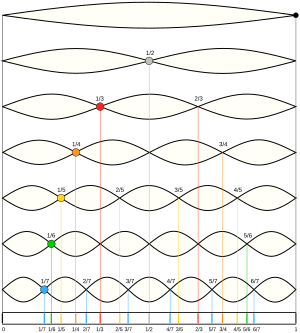Harmonic facts for kids
Imagine a sound wave, like the one from a guitar string or a speaker. A harmonic is a special part of that sound's frequency that is a perfect multiple of its main, lowest sound. This main, lowest sound is called the fundamental frequency.
Think of it like this: if the fundamental frequency is "1f" (the basic sound), then the harmonics are "2f", "3f", "4f", and so on. The second harmonic (2f) vibrates twice as fast as the fundamental. The third harmonic (3f) vibrates three times as fast. This idea works for all kinds of waves, like light or radio waves, but we often talk about it with sound.
Contents
What are Harmonics?
A harmonic is a signal's frequency that is a whole number multiple of its main, lowest frequency. This lowest frequency is known as the fundamental frequency. It's the basic building block of a periodic waveform.
For example, if a sound has a fundamental frequency of 100 Hertz, its harmonics would be:
- Second harmonic: 200 Hertz (2 x 100 Hz)
- Third harmonic: 300 Hertz (3 x 100 Hz)
- Fourth harmonic: 400 Hertz (4 x 100 Hz)
And so on. These harmonics are what give sounds their unique qualities, like why a guitar sounds different from a piano playing the same note.
Harmonics in Music and Sound
Harmonics are very important in music. When you play a note on an instrument, you don't just hear the fundamental frequency. You also hear many harmonics mixed in. These harmonics are often called overtones. The mix of different harmonics is what creates the unique sound, or timbre, of each instrument.
For example, a flute and a clarinet playing the same note (same fundamental frequency) will sound different because they produce different strengths of harmonics. This is why you can tell them apart!
What are Interharmonics?
Sometimes, you might find frequencies that are not perfect whole number multiples of the fundamental frequency. These are called interharmonics. They fall in between the main harmonics.
For example, if the fundamental frequency is "f", an interharmonic might be 1⅓f. This means it's between the first harmonic (1f) and the second harmonic (2f). Interharmonics can happen naturally in sounds, like in music, or in electrical energy systems.
Related pages
Images for kids
See also
 In Spanish: Armónico para niños
In Spanish: Armónico para niños



